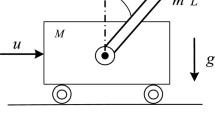Abstract
This article compares two controllers used in a liquid-level networked control system, examining their design and practical implementation. The first is an adaptive controller employing the indirect self-tuning regulator (STR) technique, while the second is a robust proportional-integral (PI) controller based on Kharitonov’s theorem. The system model is derived from the least squares algorithm concepts, and the robust PI controller is designed accordingly. Furthermore, the system parameters are estimated using the recursive least squares algorithm, serving as an online system identification method for implementing the indirect STR adaptive controller. By utilizing these estimated parameters, the STR controller is developed by the methodology of pole placement. The dynamics of the liquid-level control system are altered by introducing an external heterogeneous object into the tank to evaluate and compare the performance and efficiency of the two controllers in terms of setpoint tracking and transient response characteristics. A robust PI controller based on Kharitonov’s theorem ensures system stability for variable dynamics systems. However, due to variations in the system dynamics, system transient response characteristics will be undesirable. Adaptive controllers are employed to identify changes in the dynamics of a system with varying parameters and regulate the system effectively. The experimental findings demonstrate that the indirect STR adaptive controller surpasses the robust PI controller in performance and effectiveness of transient response characteristics.











Similar content being viewed by others
Availability of data and materials
Our article presents experimental research that necessitates the availability of the system to perform the experiments.
Abbreviations
- a i, b i :
-
System transfer function coefficient
- k p , k i :
-
Proportional and integrator coefficient of PI controller
- STR:
-
Self-tuning regulator
- LTI:
-
Linear time invariant
- NTI:
-
Nonlinear time invariant
- LS:
-
Least squares
- RLS:
-
Recursive least squares
- NLTV:
-
Nonlinear time variant
- SOPTD:
-
Second-order plus time delay
- ADC:
-
Analog to digital converter
- DAC:
-
Digital to analog converter
- ITAE:
-
Integral of the time-weighted absolute error
- NCS:
-
Networked control system
- FLC:
-
Fuzzy logic controller
References
Gu DW, Petkov PH, Konstantinov MM (2013) Robust control design with MATLAB, 2nd ed. Springer
Asadi F, Abut N (2021) Kharitonov’s theorem: a good starting point for robust control. Int J Electrical Eng Educ 58(1):57–82
Petersen IR, Tempo R (2014) Robust control of uncertain systems: Classical results and recent developments. Automatica 50(5):1315–1335
. Siddhartha V, Hote YV (2022) Robust PID controller design for DC-DC converters: the buck converter. In: 2022 IEEE electrical power and energy conference (EPEC), IEEE, pp 30–37
Sureshkumar A, Gunabalan R (2022) Design of robust guaranteed margin stability region PI controller for automotive LED lighting with parameter uncertainty. IEEE Access 10:15657–15670
Åström KJ, Wittenmark B (1995) Adaptive control. Addison-Wesley
Bertino A, Naseradinmousavi P, Kelkar A (2021) Analytical and experimental decentralized adaptive control of a high-degrees-of-freedom robot manipulator. J Dyn Syst Measure Control 143(7)
Khoshnood A, Roshanian J, Jafari A, Khaki-Sedigh A (2010) An adjustable model reference adaptive control for a flexible launch vehicle
Mollaee H, Ghamari SM, Khavari F (2022) Self-tuning regulator adaptive controller design for DC-DC boost converter with a novel robust improved identification method. IET Power Electronics 15(13):1365–1379
Anavatti SG, Santoso F, Garratt MA (2015) Progress in adaptive control systems: past, present, and future. In: 2015 International conference on advanced mechatronics, intelligent manufacture, and industrial automation (ICAMIMIA),: IEEE, pp 1–8
Goodwin GC, Sin KS (2014) Adaptive filtering prediction and control. Courier Corporation
Hou Z, Jin S (2013) Model free adaptive control. CRC Press Boca Raton, FL, USA
Chavoshi H, Salasi A, Payam O, Khaloozadeh H (2023) Experimental comparison of STR and PI controllers on a nonlinear liquid-level networked control system. In: 2023 15th International conference on electronics, computers and artificial intelligence (ECAI), IEEE, pp 1–8
Jiang P (2021) Summary of PID control system of liquid level of a single-capacity tank. In: Journal of physics: conference series, vol 1865, no 2: IOP Publishing, p 022061
Al Tahtawi AR, Yahya S, Setiadi B, Marsya C (2020) The implementation of embedded fuzzy logic controller on liquid level control system. In: International seminar of science and applied technology (ISSAT 2020), Atlantis Press, pp 161–166
Le A (2011) Liquid-Level monitoring using a pressure sensor. Eng N Semiconductor
Walsh GC, Beldiman O, Bushnell L (1999) Asymptotic behavior of networked control systems. In: Presented at the proceedings of the IEEE international conference on control applications
Tipsuwan Y, Chow M-Y (2003) Control methodologies in networked control systems. Control Eng Pract 11(10):1099–1111
Söderström T, Stoica P (1989) System identification. Prentice Hall
Bhattacharyya SP, Chapellat H, Keel LH (1995) Robust control: the parametric approach. Prentice Hall PTR
Martins FG (2005) Tuning PID controllers using the ITAE criterion. Int J Eng Educ 21(5):867
Matušů R, Prokop R (2013) Robust stability analysis for systems with real parametric uncertainty: implementation of graphical tests in Matlab. Int J Circuits Syst Signal Process
Barmish BR, Jury E (1994) New tools for robustness of linear systems. IEEE Trans Autom Control 39(12):2525–2525
Funding
The authors did not receive support from any organization for the submitted work. Also, the authors have no relevant financial or non-financial interests to disclose.
Author information
Authors and Affiliations
Contributions
All authors contributed to the study conception and design. Material preparation, data collection, and analysis were performed by HRC, OP, and AHS. All authors wrote, read, and approved the final manuscript.
Corresponding author
Rights and permissions
Springer Nature or its licensor (e.g. a society or other partner) holds exclusive rights to this article under a publishing agreement with the author(s) or other rightsholder(s); author self-archiving of the accepted manuscript version of this article is solely governed by the terms of such publishing agreement and applicable law.
About this article
Cite this article
Chavoshi , H.R., Payam, O., Salasi, A.H. et al. Robust control design of a nonlinear liquid-level networked control system: a comparative study between STR and Kharitonov analysis. Int. J. Dynam. Control (2023). https://doi.org/10.1007/s40435-023-01328-w
Received:
Revised:
Accepted:
Published:
DOI: https://doi.org/10.1007/s40435-023-01328-w




